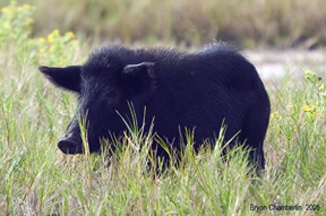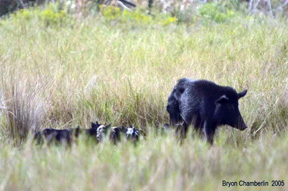Hogs Gone Wild - Experts Say Feral Pig Problem Here to Stay
By Mary Kelley Hoppe
 |
Feral hogs resemble domestic hogs, but they are leaner and meaner — well adapted to surviving in the wild. Unlike their cartoon and barnyard counterparts, they’re also far more intelligent and swift of hoof. With a disc-shaped snout teeming with olfactory nerves, nothing escapes their extraordinary sense of smell, not even buried insect larvae, worms and tubers. While acorns are their favorite food, they will eat almost anything they can uncover or overcome, including snakes, lizards, frogs, even deer fawns. Females or sows and their young travel in herds, which may number from five to 50. Older males, the boars, usually live alone, rejoining the herd when sows are in heat. Their tusks continually grow and grind together. The harder top tusk functions like a whetstone, keeper the longer bottom tusk razor-sharp.
|
The wild pigs wreaking havoc on preserves around Tampa Bay aren’t native to Florida – but they’ve been here so long they think they own the place.
We have Christopher Columbus, Hernando DeSoto and other pork-smitten early settlers to thank for that. European hogs arrived by boat centuries ago, and they either escaped primitive pig roasts or were released into the wild some 500 years ago. It’s been a hog’s heaven ever since then, with piggies hoofing it as far north as Canada, and into at least 35 states. But they feel especially at home in Florida.
And that’s the problem.
An estimated 500,000 wild pigs now roam the Sunshine State; only Texas has more. The tusky invaders host a variety of nasty diseases and parasites, from cholera, tuberculosis, salmonella and anthrax to pesky fleas, ticks and lice. And if they haven’t already arrived, chances are they’re coming soon to a preserve near you.
“Feral hogs are a big problem on all conservation lands,” according to Kevin Love, a land manager with the Southwest Florida Water Management District, who calls them one of the most severe exotic problems facing Florida.
They roam in large groups, chow down on just about anything they can get their snouts on – including native frogs, snakes and ground nesting birds – and generally make a giant mess of things. “A sow and few pigs will just move along and eat all night long – rooting up the ground with their snouts – destroying acre upon acre,” Love says. Virtually overnight, they can change the entire plant composition of the land by scooping up indigenous species and clearing a path for monocultures of invasive plants.
When they’re not rooting for grubs and acorns, pigs also trample and knock down huge swaths of native vegetation and crops.
“You can trap them, you can hunt them, but unless you significantly reduce the population at any one time and repeatedly, they’re just going to fill the plate right back up.”
A pig reaches sexual maturity before it is a year old and can produce two, and sometimes more, litters a year. A litter can number a dozen.
That’s a lot of rip-rooting piglets.
“They’re kind of like cockroaches,” says Hillsborough County Conservation Manager Ross Dickerson. “For every one you see there are probably 30 to 40 more in the woods.”
 |
|
Life on the lamb is pretty good for this sow and her piglets, which were spotted on conservation lands owned by the Southwest Florida Water Management District. But for land managers and farmers, their boorish behavior causes big headaches. When they’re not tearing up the ground in search of grubs and acorns, they also trample native vegetation and crops.
Photo: Bryon Chamberlin
|
Encroaching development is only making matters worse. Hogs, after all, need a place to call home, and they’ve found it on Florida’s preserves. And with a population gone hog-wild and few natural predators, they are a constant threat to native animals. “They’ll eat gopher tortoise eggs, indigo snakes – basically everything we’re trying to protect,” Dickerson says.
Close Encounters
To control feral hogs, land managers resort to hunting, trapping and fencing, but it’s a constant uphill battle. Even with hunts on seven different wildlife management areas, says Love, “we’re just kind of scooping up the excess off the edges – and not really having any real effect on the population as a whole.”
Male pigs can be particularly intimidating, tipping the scales at up to 300 pounds. And while most pigs will avoid humans, they can become aggressive when trapped. Love recalls one particularly hair-raising encounter by a district “fence rider” named Quet (pronounced Kweet) Boyette, a hardy cracker who lived and worked in the Withlacoochee Forest. “Quet drove out in this rye field with his 22-gauge shotgun,” Love said. “He shot the hog – the hog started running – he shot the hog again – and the hog charged him, cutting him up with his tusks and tossing him upside down.”
Lesson learned, Love says: “Use a bigger gun.”
Both the water management district and the county hire hog contractors to trap or quarantine pigs that may ultimately be sold for slaughter. Dickerson says the most the county has ever recovered is 200 to 300 animals in a single year – a drop in the bucket against a swelling swine population.
In Florida, some of the highest densities of feral hogs can be found north and west of Lake Okeechobee where large forested tracts, dense vegetation, abundant water and limited public access provide an ideal environment for pigs.
Some managers like Love express hope of finding a swine contraceptive that could be distributed in food pellets dropped from airplanes – a tactic that has been effective in stalling rabies outbreaks in raccoons. The challenge, he acknowledges, is finding a contraceptive that would work only on feral pigs and packaging it in a bait attractive to swine.
Love believes one reason Florida wildlife managers haven’t gotten more serious about eradicating nuisance pigs is that hog hunting is big sport. “People who love to hunt hogs love it more than life itself,” he says. Years ago at a public hunt in the Green Swamp, Love overhead two hunters boasting to everyone in earshot at a check-in station. “Man, we got a permit and our boss wouldn’t let us come,” said one, with a big smile on his face.
“So we quit!”
Back to Top